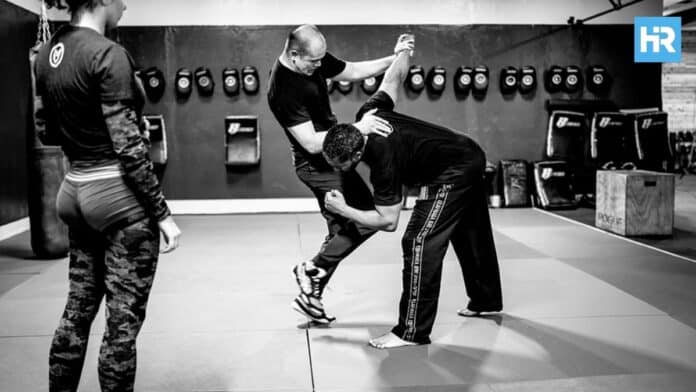Today, Krav Maga is recognized as one of the world’s most powerful and effective self-defense systems.
It is used by soldiers, police, and everyday people to stay safe in real-life situations.
Far from traditional martial arts that follow strict rules, Krav Maga was designed for real-world survival, where there are no referees, rounds, or second chances.
But how did it come to be?
What inspired its creation, and why has it spread across the world, changing the way people think about self-defense?
To understand what makes Krav Maga so different, we need to dig into its history—the story of a man, a war, and the need for a system that could keep people alive when nothing else could.
- Krav Maga was created for survival, not sport. Imi Lichtenfeld developed it in the 1930s to help Jewish communities defend themselves against violent attacks.
- The Israeli military made Krav Maga its official combat system. The Israeli Defense Forces (IDF) adopted Krav Maga because it is easy to learn and effective in real combat situations.
- Krav Maga is now used worldwide. It is practiced by the military, police, and civilians who want to learn real self-defense skills that work in dangerous situations.
Krav Maga Origin: Why It Was Created in the First Place
The story of Krav Maga begins with Imi Lichtenfeld, the man who designed this powerful self-defense system.
Imi was born in 1910 in Budapest, Hungary, but he grew up in Bratislava, Slovakia.
And his father, Samuel Lichtenfeld, was a police officer and self-defense instructor.
Growing up, Imi learned boxing, wrestling, and gymnastics, and he became very good at all three.
But in the late 1930s, everything changed.
Anti-Semitic riots broke out in Bratislava, and Jewish neighborhoods were under attack.
Imi realized that the fighting skills he had learned in boxing and wrestling were not enough for real-life street fights.
So, he started adapting his skills into something more effective for survival.
As Nazi forces spread across Europe, Imi was forced to flee his home in 1940.
He eventually made it to Palestine, where he joined the Haganah, a Jewish military group that was training to protect Jewish settlements.
The Haganah needed a simple and fast way to teach their soldiers how to fight, and Imi’s experience made him the perfect person to help.
Krav Maga Becomes the Israeli Self-Defense System
By the time Israel became an independent country in 1948, its new military, the Israel Defense Forces (IDF), needed an effective hand-to-hand combat system.
They turned to Imi, who was made the Chief Instructor of Physical Fitness and Krav Maga at the IDF School of Combat Fitness.
For the next 20 years, Imi worked to make Krav Maga as simple, effective, and easy to learn as possible.
His goal was to train soldiers—most of whom had no fighting experience—so they could defend themselves in battle with just a few months of training.
Unlike traditional martial arts, which take years to master, Krav Maga was designed to be learned quickly. The fighters needed a system that would help them stay alive in dangerous situations.
That’s why Krav Maga focused on natural movements, quick reactions, and attacking an enemy’s weak points.
The IDF saw how effective Krav Maga was, and soon, it became the official self-defense system of the Israeli military, police, and special forces.
Bringing Krav Maga to Civilians and the Rest of the World
After retiring from the military in 1964, Imi didn’t stop working.
He realized that civilians could also benefit from learning how to protect themselves.
He adjusted Krav Maga so that anyone, regardless of age, size, or fitness level, could learn it.
In 1978, Imi and his top students created the Krav Maga Association, which focused on teaching the system to the public.
This would be the beginning of Krav Maga spreading beyond Israel.
Soon, the International Krav Maga Federation (IKMF) was founded, and experts like Avi Moyal helped to grow its reach worldwide.
By the 1980s, Krav Maga had made its way to the United States.
It first gained attention in 1981 when Israeli instructors traveled to the U.S. to demonstrate their techniques at Jewish Community Centers.
Their skills impressed the FBI, which invited them to train their agents at Quantico, Virginia.
By 1985, Krav Maga had become part of law enforcement training in the U.S.
Soon, major agencies like the Los Angeles Police Department (LAPD), DEA, and U.S. military special forces were using it.
Darren Levine, a student of Imi’s, brought Krav Maga to America.
He helped open Krav Maga Worldwide in Los Angeles, making it easier for Americans to learn the system.
Today, Krav Maga training centers can be found all over the world, and its popularity continues to grow.
Why Krav Maga is Different from Other Martial Arts
Krav Maga is not a sport, and it’s strictly meant only for real-life self-defense.
One of the biggest differences is that Krav Maga focuses on ending a fight as quickly as possible.
Instead of blocking an attack and then countering, Krav Maga teaches people to defend and attack at the same time.
It also targets the weakest points of the attacker’s body—the eyes, throat, groin, and joints.
Hitting these areas causes the most damage and allows the defender to escape.
Krav Maga is also about being aware of the danger before it even happens.
Students learn to spot threats early and avoid dangerous situations whenever possible.
After all, the best fight is the one you don’t have to be in.
But if there’s no way out, Krav Maga makes sure you’re ready to react instantly, fight back hard, and get away safely.
The Importance of the Groin Kick and Other Moves
In Krav Maga, one of the first moves students learn is the front kick to the groin, due to it being among the most effective and fastest ways to stop an attacker.
A strong groin kick can cause so much pain that the attacker is unable to continue fighting.
To perform a groin kick properly, students are taught to stand in a fighting stance, lift their knees, and drive their foot upward into the attacker’s groin.
The goal is to hit with the top of the foot or shin to strike with enough power to cause serious discomfort.
Other important moves include:
- Eye gouges, which can temporarily blind an attacker
- Throat strikes, which make breathing difficult
- Elbow and knee strikes, which work well in close fights
- Techniques for disarming knives and guns, which help when facing an armed attacker
How Often Should You Train in Krav Maga?
Many people ask how often they should train in Krav Maga.
Since the system was designed for quick learning, even beginners can become proficient in a short time.
However, to truly develop the skills, regular practice is necessary.
Most Krav Maga training programs recommend:
- 3 sessions per week to build solid self-defense skills
- More than 3 sessions per week for faster progress and better conditioning
- Supplementary training, such as strength and conditioning for improved performance
Those who train 5 to 7 times a week can quickly reach high skill levels, but even those who practice once or twice a week can gain valuable self-defense knowledge.
Krav Maga in Movies and Modern Training
Today, Krav Maga is used by elite military units, police officers, and security forces worldwide.
Agencies like the FBI, DEA, Mossad, and Israeli special forces rely on it for their hand-to-hand combat training.
Krav Maga has also become popular in Hollywood movies and TV shows.
Films like Taken and The Bourne Identity show actors using Krav Maga techniques in fight scenes.
TV shows like NCIS and 24 have also featured Krav Maga, and because of its growing popularity, Krav Maga training centers have opened all over the world.
Many people who are not in the military or police learn Krav Maga to get stronger, safer, and more confident.






